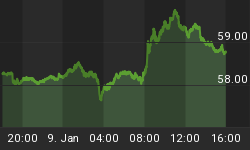This post is a slightly-modified excerpt from a recent TSI commentary.
The Federal Reserve has monetised a few trillion dollars of bonds over the past seven years without creating much in the way of what most people call "inflation" (a rise in the general price level). How could this happen?
One popular explanation is that the Fed's Quantitative Easing (QE) adds to bank reserves, but not the economy-wide money supply. According to this line of thinking, the 'money' created by the Fed to purchase bonds remains trapped in reserve accounts at the Fed. However, this explanation can be immediately eliminated, because as previously explained every dollar of QE adds one dollar to bank reserves at the Fed AND one dollar to demand deposits within the economy. The fact is that the economy-wide money supply is now a few trillion dollars larger thanks to the Fed's QE.
A second explanation is that QE isn't "inflationary" because it involves the exchange of one cash-like instrument for another. This explanation can also be immediately eliminated due to the fact that it mistakenly conflates two very different things -- money and debt securities. If you don't understand the difference, try buying something with a T-Bill. You should then understand. Also, more information on this particular issue can be found in my 9th May post at the TSI Blog.
As an aside, QE is not only NOT an exchange of one cash-like instrument for another, it involves increasing the amount of cash in the financial system and simultaneously decreasing the amount of financial assets that can be bought with cash. That is, it results in more cash 'chasing' fewer assets.
A third explanation is that the increase in the money supply stemming from the Fed's QE has been offset, in terms of effect on the general price level, by a decrease in the velocity of money. This is yet another explanation that can be eliminated, because changes in "money velocity" never explain anything. The reason is that money velocity (V) is nothing more than a fudge factor that makes one side of the tautological and practically-useless equation of exchange (MV = PQ) equal to the other side. It exists in academia, but not in the real world. For more information on the irrelevance of money velocity, refer to my 10th June post at the TSI Blog.
Having eliminated three of the fatally-flawed explanations for why the Fed's gargantuan QE hasn't yet led to problematical "price inflation", I'll now provide two explanations that make some sense.
First, for decades prior to 2008 almost all of the US economy's new money was created by commercial banks (commercial banks can loan new money into existence and they can also monetise securities). As a result, the first receivers of the new money tended to be within the 'general public' (home buyers/sellers, private businesses, etc.). However, since August-2008 almost two-thirds of all new money has been directly created by the Fed. This means that the first receivers of most of the new money were bond speculators, and that the second, third, fourth and fifth receivers of the new money were probably bond speculators or stock speculators. In other words, rather than being trapped in reserve accounts at the Fed as some people have mistakenly asserted, it is likely that a lot of the new money has effectively been trapped within the financial markets. It will eventually leak out into the 'real' economy, but due to the way the money was created/injected there has been a much longer-than-usual delay between the money creation and the inevitable effects on everyday prices.
Second, it's important to understand that even if it were possible to come up with a single number that reliably reflected the actual change in the economy-wide purchasing-power (PP) of money, this number would not tell us the "inflationary" effect of a change in the money supply. The reason is that to know the effect on money PP of a change in the money supply you have to know what would have happened to PP in the absence of the money-supply change.
For example, let's assume for the sake of argument that there is a consumer price index (CPI) that reliably indicates the change in the general price level. In our hypothetical example, the CPI would have fallen by 10% over a certain period, but due to money-pumping by the central bank the CPI increases by 2%. In this case the "inflationary" effect of the central bank's money-pumping is not a 2% increase in the CPI, it is a 12% increase in the CPI (the difference between what happened and what would have happened).
Taking into account the high private-sector debt levels that existed in 2008 and have persisted to this day, it is not hard to imagine that in the absence of the Fed's money creation there would have been a sizable decline in the CPI rather than a moderate increase. The "inflation" caused by the Fed's QE is the difference between the decline in the general price level that would have happened and the rise in the general price level that did happen.
In conclusion, there are two main contributors to the lacklustre performance of the "general price level" over the past few years. First, unlike in earlier cycles a lot of the money created during the current cycle was injected directly into the financial markets. Second, it's likely that there would have been significant "price deflation" in the absence of the money-pumping.















